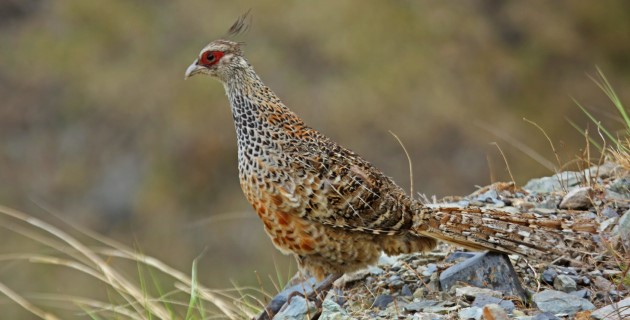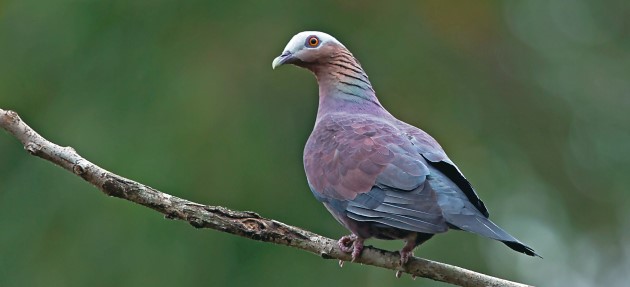Birding
First published in Sanctuary Asia,
Vol. 35
No. 6,
June 2015
By Panchami Manoo Ukil
Amateur birdwatchers or birders as we are called, are passionate about looking for as many species we can find to tick off our lists. At a personal level, apart from just revelling in the beauty of birds, the attraction lies in the promise of adventure. Nothing is in control of the birdwatcher when he or she attempts to look for birds in the wild. It is a huge exercise in patience, sometimes rewarding, often not. The adrenaline rush and excitement for birders lies in this unpredictability of outcome. At a broader level, every birdwatcher is contributing to documenting avifauna through the sheer pursuit of a hobby. Watching birds enables an overall communion with the many facets of nature and the environment. With birds, one learns and appreciates trees, flowers, water, earth, and sky. Hearing and vision are sharpened, and the virtues of patience and tolerance are honed because birders tread cautiously so as not to frighten the object of their search, or disturb nature’s harmony. The birder also gets to observe myriad other creatures in the wild and notices changes in favourite habitats over time. If birds suddenly go missing from an area, it’s a warning that something is wrong.
Women birdwatchers have been in the field at least as long as men, though admittedly in fewer numbers. As a serious birdwatcher for the past three years, my journey has been gratifying in more ways than one. Initially pursuing my passion at a personal level, I soon realised that I could and should play a larger role in creating awareness about birds and their vanishing habitats. Sharing bird images and stories of experiences in the field on social and print media gradually sparked an interest in family and friends, some of whom had no previous idea of the abundance of avifauna in their immediate surroundings.
My birding forays
My state of Odisha has great antecedents in ornithology, birdwatching, and habitat conservation, with Raja Dr. U. N. Dev being one of the most respected ornithologists in the country, and N. K. Bhujabal known for his sterling efforts in turning Mangalajodi around, from a poacher’s den to a birding paradise. Yet there was no regular dissemination of information on birds and bird habitats and no culture of community birdwatching as was the case elsewhere in India. I was inspired to start a bird walk myself (Sanctuary Asia, Vol. XXV No. 3, June 2014) in Bhubaneswar only after participating in the 2013 Delhi Bird Race. The Bhubaneswar Bird Walks (TBBW) soon introduced weekly birdwatching in different birding spots in the city. I knew from personal experience that once people began frequenting biodiverse habitats they would understand the ecosystems better and then be more prepared to conserve them. I wanted to draw more people to the magic I knew exists around us.

A Cheer Pheasant shows off its distinct, red, eye patch. Vulnerable and elusive species like this, push birders to travel far and wide to add to their ‘lifer lists’. Photo Courtesy: Panchami Manoo Ukil
The response to our Sunday morning bird walks was overwhelming. Soon a surge of birdwatching and the consequent detailed documentation of avifauna took place. Unexplored habitats were unearthed by tenacious birdwatchers and bird photographers, and the list of positively identified species in the city and its environs began to expand. Some birders began to wander further afield, exploring Odisha’s rich jungles from where fresh listing of species emerged. This has helped corroborate/supplement past records and highlight the impact of habitat degradation on the avians everyone once took for granted as part of Odisha’s backdrop. Today there are nearly 100 active birders in our group and they find their own lives enriched, as they enrich our collective pride in the state we love.

The members of TBBW number almost 100. These hobby birders have been instrumental in documenting the avifauna of Odisha, including birds like this Pale-capped Pigeon. Photo Courtesy: Panchami Manoo Ukil
The Mangalajodi wetland, which sees nearly 4,00,000 winter migrants every year, is now firmly on the national and global birders’ map. Some of the images that extremely proficient bird photographers are obtaining are nothing short of stunning. It’s much easier to protect areas that people feel proud of, and what started out as a simple, enjoyable pastime has already turned into conservation action of worth.
A rewarding experience
As a woman, I have not faced any insurmountable challenges in the field. The wilderness is full of unpredictable moments, the risks are equal for men and women. At best, the difficulties relate to the physical, in the sense that I do sometimes find it difficult to lug heavy equipment over long distances and rough terrain on foot. But, over time, resilience has been built. Most often, one is so focused on pursuing a passion that one hardly feels the hardships. The support of male co-birders on the field cannot be undermined. Recently I was in the Mishmi Hills of Arunachal Pradesh, which is considered to be one of the toughest birding terrains to traverse.
In these high altitudes, the cold and lack of basic facilities like electricity was no deterrent to determined birders. The camaraderie and bonhomie helped me overcome any discomfort that might have crept in and the birding experience proved to be beyond description.
As a woman and a mother, I find extra joy in the fact that I am able to impart knowledge and values to my child on the nuances of nature conservation. Almost by osmosis, our depleting biodiversity has become a family concern. Conservation does begin at home and mothers are best placed to create a whole new generation of ‘green warriors’ by example, gently inculcating green practices as a way of life for children. I also firmly believe that all children should be exposed to the outdoors to move them away from a cooped-up lifestyle dominated by the hypnosis of gadgets. Through time spent in nature’s unstructured playgrounds, they will progressively learn about nature and its complexities, about how important it is to respect and conserve the environment, and what they can do to leave behind the lightest possible carbon footprint.
For me personally, the road map for 2015 is crystal clear. I will make a conscious attempt to take birdwatching to school children so that awareness of natural habitats and the need to conserve biodiversity is instilled at an early age. We are designing a curriculum that includes field trips and classroom interaction at least once a fortnight through a school bird club or nature club. Children will be made aware of and encouraged to think about and express their thoughts and opinions on pressing environmental issues. None of this can or should be enforced… it has to be instilled.
I am often asked – why birds? I recently read excerpts from a book called ‘Their Fate is our Fate: How Birds Foretell Threats To Our Health and To Our World’. The author, Nobel Prize-winning immunologist, Peter Doherty, asserts that birds detect danger to our health and environment before we do. Observing different species of birds around the world over long periods of time, the scientist concluded that disease and disappearance in bird species serves as an early forewarning about threats to our own health and that of planet Earth. Early man in his intuitiveness regarded birds as sentinels and paid heed to what they considered the ‘prophetic capabilities’ of the avian universe.
Today, we don’t think twice before felling a tree, or using pesticides that end up harming us, together with all other elements of the biota. We have thus managed to wipe out entire species of birds. Bhubaneswar, for example has virtually no house sparrows. And in Odisha, irrespective of denials, the scourge of diclofenac use in veterinary hospitals, which has almost wiped out India’s vulture populations, is still real and present. Conservation cannot be isolated from development and the expansion of infrastructure that humans believe are vital to the quality of life, thus making a balanced developmental strategy all the
more imperative.
I want to leave this world a better place for my child. And the birds are helping me to do this.
Birds and our environment
To understand a little more about the intricate relationship between birds and the environment, here is an excerpt from eminent scientist Madhusudan Katti’s study on leaf warblers; These are dull, greenish-brown birds that weigh between seven to 11 grams. They are migratory birds that take over the peninsular forests of India from September to May. They number in billions and probably form the largest avian guild in the subcontinental forests during the tropical winter. Six to eight of these leaf warblers inhabit per hectare of forest. For seven to eight months these leaf warblers spend 75 per cent of their waking hours foraging for insects in the foliage. Each bird eats three insects every waking minute. The prey largely consists of leaf-eating caterpillars. A single leaf warbler therefore eats 180 insects per hour or about 1,980 insects per day, considering an 11-hour working day from dawn to dusk. Thus the six individual birds on a one hectare plot rid the plot of almost 12,000 insect pests every day. Multiply that with the 240 days of their migratory presence and we may begin to appreciate the service they render to our plants. Let us now remove these insectivore birds from the scene. Plants look ragged with tattered foliage, leaves are now packed with anti-herbivore compounds produced in response to caterpillar-nibbling. So now herbivores go hungry, plants make fewer flowers and fruits as they are forced to spend too much energy on self defence thus making frugivores and nectarivores unhappy, regeneration of the forest slows down as fewer seeds get produced and dispersed, ground starts to dry up faster as the canopy is thinner and more sunlight gets in, and the rest of the ecological cascade effects then take over. So this tells us about the important role that birds play in the background of our everyday lives and how much we actually depend on them for our survival.



